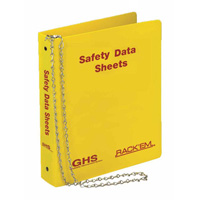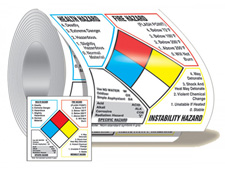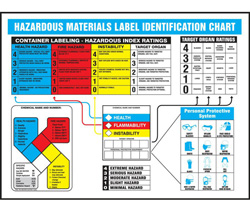| The Home page of ILPI's Safety Data Sheet (SDS) Resource, the leader in SDS information since 1995! | |
| The history and philosophy behind this resource. | |
| A curated collection of books and reference materials concerning Safety Data Sheets and closely related topics. | |
| Paste your plain text SDS into the SDS-Demystifier, and it will be converted into a hypertext-enriched document with links to detailed explanations of each key term. | |
| An extensive list of frequently asked questions about Safety Data Sheets including regulations, content, compliance, and more. | |
| A humorous take on Safety Data Sheet jargon. Fill in the blanks on our entry form to generate a personalized Unsafety Data Sheet to share with your coworkers. | |
| Since 1995, we've maintained this massive curated list of the best places to find Safety Data Sheets on the Internet. | |
| You are here! Way more than a glossary, this hypertext-enhanced resource covers hundreds of SDS-related terms and expert knowledge. Each entry includes both the SDS relevance and links to additional authoritative resources. | |
| Archived results of Safety Data Sheet related polls taken by some of our millions of site visitors | |
| The OSHA regulations behind SDS regulations, including the inspection guidelines and over 400 official interpretations letters under the Hazard Communication Standard | |
| Commercial suppliers of SDS authoring and management software as well as cloud compliance services. | |
| Commercial companies that will create SDS's for your specific needs as well as SDS translation companies. |

Safety signs, banners, and scoreboards? Get yours at Safety Emporium!

Get your SDS binders, centers and more from Safety Emporium.
Definition
The Hazardous Materials Identification System, HMIS®, was developed by the National Paint & Coatings Association (NPCA), now known as the American Coatings Association (ACA), to help employers comply with OSHA's Hazard Communication (HCS), 29 CFR 1910.1200.
The current HMIS® III version utilizes colored bars, numbers and symbols to convey the hazards of chemicals used in the workplace. See below for an explanation of the system.
Alas, this optional system is proprietary and the ACA has apparently awarded exclusive rights for HMIS® products and services to a handful of vendors. The implementation manual alone costs $299.00 USD; in contrast OSHA's mandatory GHS labeling system is open and freely available - anyone can print or sell their own labels. In our opinion, the idea of charging for use of a labeling system is totally unacceptable and runs counter to the facile dissemination of health and safety information. More importantly, because the HMIS® numeric hazard ranking scale is the reverse of the one that OSHA legally requires under HCS 2012, the chance of worker confusion, conceivably with lethal consequences, is quite high. For these and additional reasons, we strongly discourage use of the HMIS® system.
In fact, that $299.00 ACA implementation manual has an entire chapter devoted explaining how to convert the OSHA-required GHS labeling system to proprietary and non-mandatory HMIS® labels. Why on earth would anyone want to require their employees to learn an additional and confusing proprietary system when they have already complied with OSHA labeling requirements using a system that is accepted worldwide? As safety professionals, this makes our heads spin. Let's ask another question - why is an organization that deals only with paints and coatings trying to hold itself up as some sort of authority on a system users may try to apply to over 159 million known chemicals, most of which the ACA has zero experience with?
Note the following:

Communicate workplace hazards with handy labels from Safety Emporium.
- Do not confuse HMIS® with WHMIS, which is a set of Canadian Regulations dealing with hazardous materials.
- Do not confuse HMIS® labels (colored bars) with NFPA labels (colored diamonds). The two systems are similar but not identical. See below for more info.
- HMIS® is a registered mark of the ACA.
- Hazardous Materials Information System (HMIS), is the former name of a DOT Research and Special Programs Administration (RSPA) computerized information management system containing data to ensure the safe transportation of hazardous materials by air, highway, rail, and water. When DOT was reorganized in 2004, the RSPA was subsumed by DOT's Pipeline and Hazardous Materials Safety Administration which now administers the current Hazmat Incident Database which collects all incident data per 49 CR 171.16.
- The U.S. Department of Defense (DoD) used to call their restricted HMIRS (Hazardous Material Information Resource System) HMIS, but changed the name, in part, to reduce confusion with these other HMIS designations.
- The US Department of Housing and Urban Development (HUD) uses HMIS to refer to Homeless Management Information Systems.
Additional Info
At first glance, the HMIS® and NFPA labeling systems appear quite similar. Both have four sections colored blue, red, yellow and white. HMIS® uses colored bars, while NFPA uses colored diamonds. HMIS® attempts to convey full health warning information to all employees while NFPA is meant primarily for fire fighters and other emergency responders. Key point: HMIS® is not intended for emergency circumstances.
Some employers use hybrids of the two systems. For example, they will use an NFPA hazard diamond, but the white section is used to denote both personal protective equipment (PPE) and/or special hazards. The ACA and NFPA both discourage the mixing of the two systems in this manner. OSHA permits one to use any labeling system as long as it meets their labeling performance requirements. Thus, if you use a hybrid system at your location, your employees must be properly trained in using it and be made aware of these potential conflicts.
HMIS® labels can appear in a variety of formats. Some will include additional spaces to list target organ effects, a labeling requirement under 29 CFR 1910.1200, and other information, but the four colored areas shown here will always be present.
An older style HMIS® label is shown below on the left. In the April 2002 release of HMIS® III, the yellow Reactivity section was replaced with an orange Physical Hazard section as shown below on the right. Other aspects of the system were also changed (see below).


ACA recommends upgrading your older HMIS labels.
SDS Relevance
Specific sections of an HMIS® label include the following:
| Health | |
The Health section conveys the health hazards of the material. In the latest version of HMIS®, the blue Health bar has two spaces, one for an asterisk and one for a numeric hazard rating. If present, the asterisk signifies a chronic health hazard, meaning that long-term exposure to the material could cause a health problem such as emphysema or kidney damage. NFPA lacks this important information because the NFPA system is meant only for emergency or acute (short-term) exposures. According to ACA, the numeric hazard assessment procedure is different than that used by NFPA. Here are the numeric health rankings for the HMIS system: | |
| 4 | Life-threatening, major or permanent damage may result from single or repeated overexposures. |
| 3 | Major injury likely unless prompt action is taken and medical treatment is given. |
| 2 | Temporary or minor injury may occur. |
| 1 | Irritation or minor reversible injury possible. |
| 0 | No significant risk to health. |
| Flammability | |
For HMIS® I and II, the criteria used to assign numeric values (0 = low hazard to 4 = high hazard) are identical to those used by NFPA. In other words, in this category, the systems are identical. For HMIS® III, the flammability criteria are defined according to OSHA standards: | |
| 4 | Flammable gases, or very volatile flammable liquids with flash points below 73 °F, and boiling points below 100 F. Materials may ignite spontaneously with air. (Class IA). |
| 3 | Materials capable of ignition under almost all normal temperature conditions. Includes flammable liquids with flash points below 73 °F and boiling points above 100 °F, as well as liquids with flash points between 73 °F and 100 °F. (Classes IB & IC). |
| 2 | Materials which must be moderately heated or exposed to high ambient temperatures before ignition will occur. Includes liquids having a flash point at or above 100 °F but below 200 °F. (Classes II & IIIA). |
| 1 | Materials that must be preheated before ignition will occur. Includes liquids, solids and semi solids having a flash point above 200 °F. (Class IIIB). |
| 0 | Materials that will not burn. |
| Reactivity (HMIS® I and II - now obsolete) | |
The criteria used to assign numeric values (0 = low hazard to 4 = high hazard) were identical to those used by NFPA. In other words, in this category, the systems were identical. This version is now obsolete. The yellow section has been replaced with an orange section titled Physical Hazards - see the next section for more information. |
| Physical Hazard (HMIS® III) | |
Reactivity hazards are assessed using the OSHA criterion of physical hazard. Seven such hazard classes are recognized:
This version replaces the now-obsolete yellow section titled Reactivity - see the previous section for more information. As with the Health and Flammability sections, the level of hazard is indicated using numeric values (0 = low hazard to 4 = high hazard) | |
| 4 | Materials that are readily capable of explosive water reaction, detonation or explosive decomposition, polymerization, or self-reaction at normal temperature and pressure. |
| 3 | Materials that may form explosive mixtures with water and are capable of detonation or explosive reaction in the presence of a strong initiating source. Materials may polymerize, decompose, self-react, or undergo other chemical change at normal temperature and pressure with moderate risk of explosion. |
| 2 | Materials that are unstable and may undergo violent chemical changes at normal temperature and pressure with low risk for explosion. Materials may react violently with water or form peroxides upon exposure to air. |
| 1 | Materials that are normally stable but can become unstable (self-react) at high temperatures and pressures. Materials may react non-violently with water or undergo hazardous polymerization in the absence of inhibitors. |
| 0 | Materials that are normally stable, even under fire conditions, and will not react with water, polymerize, decompose , condense, or self-react. Non-explosives. |
| Personal Protection | ||||||||||||||||||||||||||
This is by far the largest area of difference between the NFPA and HMIS® systems. In the NFPA system, the white area is used to convey special hazards whereas HMIS® uses the white section to indicate what personal protective equipment (PPE) should be used when working with the material. The ACA specifically recommends that "preparers of MSDSs should not place HMIS® PPE designation codes on the MSDSs or labels that leave the facility, as they do not know the conditions under which their customers use those products." However, these still turn up on some SDS's. HMIS® uses a letter coding system for this section. We at ILPI find this unacceptable because we would rather see the PPE listed explicitly instead of having employees try to remember a bunch of codes or consult a chart, something that could lead to confusion and/or a fatal accident. Likewise, the "custom codes" aspect is particularly dangerous for visitors and contractors who may not remember/recognize that these could vary from job site to job site. Note: Some of the letters/symbols used in this table are also used as TSCA, CHIP, and/or DoD HMIRS/HCC codes, all of which have completely different meanings and applications! Say, did we tell you we dislike code systems? We present the lettering scheme here, along with a series of graphics meant to reinforce the meaning of each letter: | ||||||||||||||||||||||||||
|
NOTE: NFPA and other labeling codes (such as HMIS®) are NOT required by OSHA. OSHA has said "...OSHA does not endorse specific services or products. It would, therefore, be inappropriate for OSHA to require a particular labeling system's code on the material safety data sheet." (see this official OSHA interpretation). OSHA does have specific labeling requirements that must be fulfilled, and the hazard classifications that are required run completely counter to the now-obsolete HMIS® III sytem.
SDS Relevance

Keep informed about workplace hazards with proper labeling techniques and safety posters available from Safety Emporium.
Some manufacturers include HMIS information on their Safety Data Sheets, but there has never been an OSHA requirement for them do so.
There are a number of copycat HMIS® systems out there to get around the proprietary issues. They have very similar wording on the label and call themselves something slightly different. For example, you might see HMIG (Hazardous Material Information Guide) or HMCIS (Hazardous Materials Classification Information System). These may use the older instability vs reactive header in the yellow section, diamonds for the blanks instead of boxes, and other little nuances that differ from an HMIS® label. Again, it's the absurdity of a proprietary label system that leads to this kind of nonsense.
OSHA's adoption of the Globally Harmonized System (GHS) as part of the 2012 revision of the Hazard Communication Standard (29 CFR 1910.1200) changed container labeling requirements to include specific elements including pictograms, hazard statements, precautionary statements and a signal word. This harmonized labeling system has made HMIS® all but obsolete or redundant. However, non-mandatory NFPA 704 information is still nice to have as state or local fire codes may require 704 signage on tanks, doors and other workplace locations.
In a 2013 interpretation letter, OSHA confirmed that SDS authors may include HMIS and NFPA ratings in Section 2 of the SDS "so long as the ratings in the HMIS label do not contradict or cast doubt on the validity of label information required by HCS 2012 (C.3.1) or impede the user's ability to identify the information required by HCS 2012 (C.3.2)".
We have emphasized the last part of that statement. Given that HMIS ranks 1 as low and 4 as high hazard whereas the HCS ranks 1 as high and 4 as low, it seems exceedingly likely that even trained employees will be confused if both systems are in simultaneous use, particularly at multi-employer workplaces. For example, using the two systems at the same time could result in a label with an HMIS® flammability rating of 4 but a (required) GHS flammability classification of 1 on the same label! Therefore, we strongly discourage employers from using the HMIS® system given the potential for confusion with the mandatory OSHA hazard classification and categorization system.
Further Reading
- A 2014 HMIS Sample Training Presentation courtesy of the ACA.
- NFPA, HMIS and OSHA's GHS Aligned Hazard Communication Standard at VelocityEHS.
- Aligning The Hazardous Materials Identification System (HMIS®) with the Updated OSHA Hazard Communication Standard (HCS 2012), a 2015 PowerPoint presentation from the Society for Chemical Hazard Communication.
- GHS Hazard Classifications in Relation to HMIS® III & NFPA 704 Rating Systems at Waxie.
See also: combustible, flammable, health hazard, smoke









